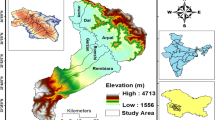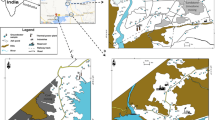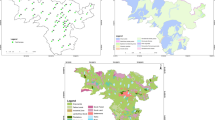Abstract
In this systematic research work, fifty-four groundwater samples of Solan and Shimla districts of Himachal Pradesh, India, have been analysed for heavy metals like As, Cd, Cr, Co, Cu, Ni and Pb using atomic absorption spectrophotometer as well as physico-chemical parameters like pH, redox potential, electrical conductivity and total dissolved salts (TDS). Most of the water samples were found to be alkaline. Based on their TDS values, 53 groundwater samples were considered 'fresh' and 'desirable for drinking'. The investigated groundwater samples were found to be heavily contaminated with As, Co, Cr, Ni and Pb, as their average values of 84.3, 106.7, 101.4, 84.1 and 131.9 ppb, respectively, far exceeded the guideline values recommended by World Health Organization and United States Environment Protection Agency. Doses due to ingestion via drinking water pathway and dermal absorption were computed for two different age groups of child and adult. The non-carcinogenic risk expressed in terms of target hazard quotient was found to be greater than unity for As, Co, Cr and Pb. The average carcinogenic risk of As and Cr calculated as 1.56 × 10–3 and 2.38 × 10–2, respectively, crossed the acceptable range of 10–6–10–4. It may thus be concluded that the residents of the study region have high probability of develo** adverse health effects from heavy metal exposure.








Similar content being viewed by others
References
Agency for Toxic Substances and Disease Registry (ATSDR) (1995) Public health assessment, Blackbird Mine, Cobalt, Lemhi County, Idaho. CERCLIS No. IDD980725832. Atlanta, GA, United States Department of Health and Human Services, Public Health Service. http://www.atsdr.cdc.gov/HAC/PHA/blackbird/bla_toc.html.
Arsenic in drinking water (1999) National Research Council. National Academy Press, Washington, DC
Arsenic in drinking-water. (2011b) Background document for preparation of WHO Guidelines for drinking-water quality. Geneva, World Health Organization (WHO/SDE/ WSH/03.04/75/Rev/1).
Aydinal C, Cresser MS (2009) Distribution of heavy metals in irrigated vertisol profiles in semiarid region of Turkey. Polish J Environ Studies 18(4):539–545
Bureau of Indian Standards (BIS) (1991) Analysis of water and waste water. BIS Institution, Nagpur
Bureau of Indian Standards (BIS) (2012) Specification for drinking water. 1S: 10500. Bureau of Indian Standards, New Delhi.
Cadmium in drinking-water. (2011c) Background document for preparation of WHO Guidelines for drinking-water quality. Geneva, World Health Organization (WHO/SDE/ WSH/03.04/80/Rev/1).
Chromium in drinking-water (2003a) Background document for preparation of WHO Guidelines for drinking-water quality. Geneva, World Health Organization (WHO/SDE/ WSH/03.04/4).
Copper in drinking-water (2003b) Background document for preparation of WHO Guidelines for drinking-water quality. Geneva, World Health Organization (WHO/SDE/ WSH/03.04/88).
Davis SN, DeWiest RJM (1967) Hydrology (2nd ed., p. 463). New York, London.
Duggal V, Rani A, Mehra R (2014) Monitoring of metal contaminations in groundwater in Northern Rajasthan. India. J Environ Occup Sci 3(2):114–118. https://doi.org/10.5455/jeos.20140223121124
García R and Báez AP (2012) Atomic Absorption Spectrometry (AAS), Atomic Absorption Spectroscopy, Dr. Muhammad Akhyar Farrukh (Ed.), ISBN: 978–953–307–817–5, InTech, Available from: http://www.intechopen.com/books/atomic-absorption-spectroscopy/atomic-absorption-spectrometry-aas
Goncharuk VV, Bagrii VA, Mel’nik LA, Chebotareva RD, Bashtan SY (2010) The use of redox potential in water treatment processes. J Water Chem Technol 32:1–9. https://doi.org/10.3103/S1063455X10010017
Gros M, Petrovic M, Ginebreda A, Barcelo D (2010) Removal of pharmaceuticals during wastewater treatment and environmental risk assessment using hazard indexes. Environ Int 36(1):15–26. https://doi.org/10.1016/j.envint.2009.09.002
Heath RC (1998) Basic Ground-Water Hydrology, U.S. Geological Survey Water-Supply Paper 2220, http://water.usgs.gov/pubs/wsp/wsp2220, Denver, CO.
International Agency for Research on Cancer (IARC) (2009). A Review of Human Carcinogens-Part C: Metals, Arsenic, Dusts, and Fibers.
International Organization for Standardization (ISO). Water quality - Sampling - Part 3: Preservation and Handling of water samples. ISO5667–3:2018(en).
International Organization for Standardization (ISO). Water quality - Determination of electrical conductivity. ISO-7888:1985.
Jain CK, Sharma SK, Singh S (2018) Physico-chemical characteristics and hydrogeological mechanisms in groundwater with special reference to arsenic contamination in Barpeta District, Assam (India). Environ Monit Assess 190(7):417. https://doi.org/10.1007/s10661-018-6781-5
Jakhu R, Mehra R (2018) Risk estimation and multivariate statistical analysis of the heavy metal content of drinking water. Toxicol Ind Health 34(10):714–725. https://doi.org/10.1177/0748233718773024
Kamaldeep, Rishi MS, Kochhar N, Ghosh N (2011) Impact of industrialization on groundwater quality: a case study of Baddi-Barotiwala industrial belt, Distt. Solan, Himachal Pradesh, India. J Ind Pollut Control, 27(2): 153–159.
Kaur S, Mehra R (2019) Toxicological risk assessment of protracted ingestion of uranium in groundwater. Environ Geochem Health 41(2):681–698. https://doi.org/10.1007/s10653-018-0162-4
Kumar M, Rahman MM, Ramanathan AL, Naidu R (2016) Arsenic and other elements in drinking water and dietary components from the middle Gangetic plain of Bihar, India: health risk index. Sci Total Environ 539:125–134. https://doi.org/10.1016/j.scitotenv.2015.08.039
Lead in drinking-water. (2011d) Background document for preparation of WHO Guidelines for drinking-water quality. Geneva, World Health Organization (WHO/SDE/WSH/03.04/9/ Rev/1).
Lu Y, Xu J, Wang H, Liu X, Li W (2019) Distribution, sources and health risk assessment of contaminations in water of urban park: a case study in Northeast China. Environ Geochem Health 41(6):2473–2489. https://doi.org/10.1007/s10653-019-00293-8
Michalski R, Pecyna-Utylska P, Kernert J, Grygoyć K, Klyta J (2020) Health risk assessment of selected metals through tap water consumption in Upper Silesia. Poland J Environ Health Sci Eng 18(2):1607–1614. https://doi.org/10.1007/s40201-020-00579-5
Mukherjee I, Singh UK, Singh RP, Anshumali KD, Jha PK, Mehta P (2020) Characterization of heavy metal pollution in an anthropogenically and geologically influenced semi-arid region of east India and assessment of ecological and human health risks. Sci Total Environ 705:135801. https://doi.org/10.1016/j.scitotenv.2019.135801
Nickel in drinking-water (2005) Background document for development of WHO Guidelines for drinking-water quality. Geneva, World Health Organization (WHO/SDE/ WSH/05.08/55).
Ogunfowokan AO, Oyekunle JAO, Olutona GO, Atoyebi AO, Lawal A (2013) Speciation study of heavy metals in water and sediments from Asunle River of the Obafemi Awolowo University, Ile-Ife. Nigeria Int J Environ Prot 3(3):6
Patel KS, Sahu BL, Dahariya NS, Bhatia A, Patel RK, Matini L, Sracek O, Bhattacharya P (2017) Groundwater arsenic and fluoride in Rajnandgaon District, Chhattisgarh, northeastern India. Appl Water Sci 7(4):1817–1826. https://doi.org/10.1007/s13201-015-0355-2
Prasad M, Kumar GA, Sahoo SK, Ramola RC (2019) Health risks associated with the exposure to uranium and heavy metals through potable groundwater in Uttarakhand state of India. J Radioanal Nucl Chem 319:13–21. https://doi.org/10.1007/s10967-018-6281-7
Rahman MM, Dong Z, Naidu R (2015) Concentrations of arsenic and other elements in groundwater of Bangladesh and West Bengal, India : potential cancer risk. Chemosphere 139:54–64. https://doi.org/10.1016/j.chemosphere.2015.05.051
Rajappa B, Manjappa S, Puttaiah ET (2010) Monitoring of heavy metal concentration in groundwater of Hakinaka Taluk, India. Contemporary Eng Sci 3(4):183–190
Rao DP, Bhattacharya A, Reddy PR (1986) Use of IRS-IC Data for geological and geographical studies. Current Sci Special Session: IRS-IC 70(7):619–623
Ravindra K, Mor S (2019) Distribution and health risk assessment of arsenic and selected heavy metals in groundwater of Chandigarh, India. Environ Pollut 250:820–830. https://doi.org/10.1016/j.envpol.2019.03.080
Saleh HN, Panahande M, Yousefi M, Asghari FB, Conti GO, Talaee E, Mohammadi AA (2019) Carcinogenic and non-carcinogenic risk assessment of heavy metals in groundwater wells in Neyshabur Plain. Iran Biol Trace Elem Res 190:251–261. https://doi.org/10.1007/s12011-018-1516-6
Sharma C, Mahajan A, Garg UK (2013) Assessment of arsenic in drinking water samples in south-western districts of Punjab-India. Desalin Water Treat 51:5701–5709. https://doi.org/10.1080/19443994.2012.760109
Sharma S, Nagpal AK, Kaur I (2019) Appraisal of heavy metal contents in groundwater and associated health hazards posed to human population of Ropar wetland, Punjab, India and its environs. Chemosphere 227:179–190. https://doi.org/10.1016/j.chemosphere.2019.04.009
Singh K, Singh R, Malyan SK, Rawat M, Kumar P, Kumar S, Sharma MK, Pandey G (2018) Health risk assessment of drinking water in Bathinda district, Punjab. J Indian Water Resour Soc 38(3):34–41
Smith IC, Carson BL (1981) Trace metals in the environment. MI, Ann Arbor Science Publishers, Ann Arbor
Srivastava S, Sharma YK (2013) Arsenic occurrence and accumulation in soil and water of eastern districts of Uttar Pradesh, India. Environ Monit Assess 185:4995–5002. https://doi.org/10.1007/s10661-012-2920-6
The water act (Act 54 of 1956) and its requirements in terms of water supplies for drinking water and for waste water treatment and discharge into the environment.
US Agency for Toxic Substances and Diseases Registry (USATSDR) (1999) Lead Toxicological Profiles. Atlanta: Centres for Diseases Control and Prevention PB/99/166704.
US Environment Protection Agency (USEPA) (1986) Air quality criteria document for Lead. Environmental Criteria and Assessment Office, US Environmental Protection Agency, Research Triangle Park, North Carolina
United States Environmental Protection Agency (USEPA) (2002) Supplemental guidance for develo** soil screening levels for superfund sites OSWER 9355.4–24. Washington, DC, USA: EPA540/F-95/041. https://www.epa.gov/superfund/superfund-soil-screeningguidance.
United States Environmental Protection Agency (USEPA) (2010) Integrated risk information system (IRIS). Washington, DC, USA. Available online: www.epa.gov/ncea/iris/index.html (Accessed July 15, 2020)
United States Environmental Protection Agency (USEPA) (2012) Guidelines for Drinking-Water Quality, Edition of the Drinking-Water Standards and Health Advisories EPA. 822-S-12–001.
Vetrimurugan E, Brindha K, Elango L, Ndwandwe OM (2017) Human exposure risk to heavy metals through groundwater used for drinking in an intensively irrigated river delta. Applied Water Science 7:3267–3280. https://doi.org/10.1007/s13201-016-0472-6
World Health Organization (WHO) (2020). Ten Chemicals of Major Public Health Concern. Available online: ttp://www.who.int/ipcs/ assessment/public_health/chemicals_phc/ en/ (Assessed on September 08, 2020).
World Health Organization (2011) Guidelines for drinking-water quality, 4th edn. Switzerland, Geneva
World Health Organization (2004) Guidelines for drinking water quality, vol 1, 3rd edn. Switzerland, Geneva
World Health Organization (1993) Guidelines for drinking-water quality, 2nd edn. Switzerland, Geneva
World Health Organization (2006) Guidelines for Drinking Water Quality-II. Environmental Health Criteria, Geneva
Acknowledgements
The authors express their sincere gratitude to Department of Science and Technology, Government of India, for providing fellowship under DST-INSPIRE scheme IF160030. The authors are also thankful to Director, Dr. B R Ambedkar National Institute of Technology, Jalandhar for providing state-of-the-art facilities in laboratory and the residents of the study area for their kind co-operation during field work.
Funding
The study was funded by Department of Science and Technology, Government of India under DST-INSPIRE scheme IF160030.
Author information
Authors and Affiliations
Contributions
All the authors contributed to the study conceptualization and design. Material preparation, data collection and analysis were performed by Sarabjot Kaur. The first draft was prepared by Sarabjot and M. Rajesh. All authors read and approved the final manuscript.
Corresponding author
Ethics declarations
Conflict of interest
The authors declare they have no financial interests. All authors certify that they have no affiliations with or involvement in any organization or entity with any financial interest or non-financial interest in the subject matter or materials discussed in this manuscript. Authors are responsible for correctness of the statements provided in the manuscript.
Ethical approval
This article does not contain any studies with human participants or animals performed by any of the authors.
Additional information
Editorial responsibility: Samareh Mirkia.
Rights and permissions
About this article
Cite this article
Kaur, S., Mehra, R. & Kumar, M.R. Quantification of health risks and spatial distribution of heavy metals in groundwater of Lower Himalayas, India. Int. J. Environ. Sci. Technol. 19, 3201–3218 (2022). https://doi.org/10.1007/s13762-021-03258-6
Received:
Revised:
Accepted:
Published:
Issue Date:
DOI: https://doi.org/10.1007/s13762-021-03258-6




